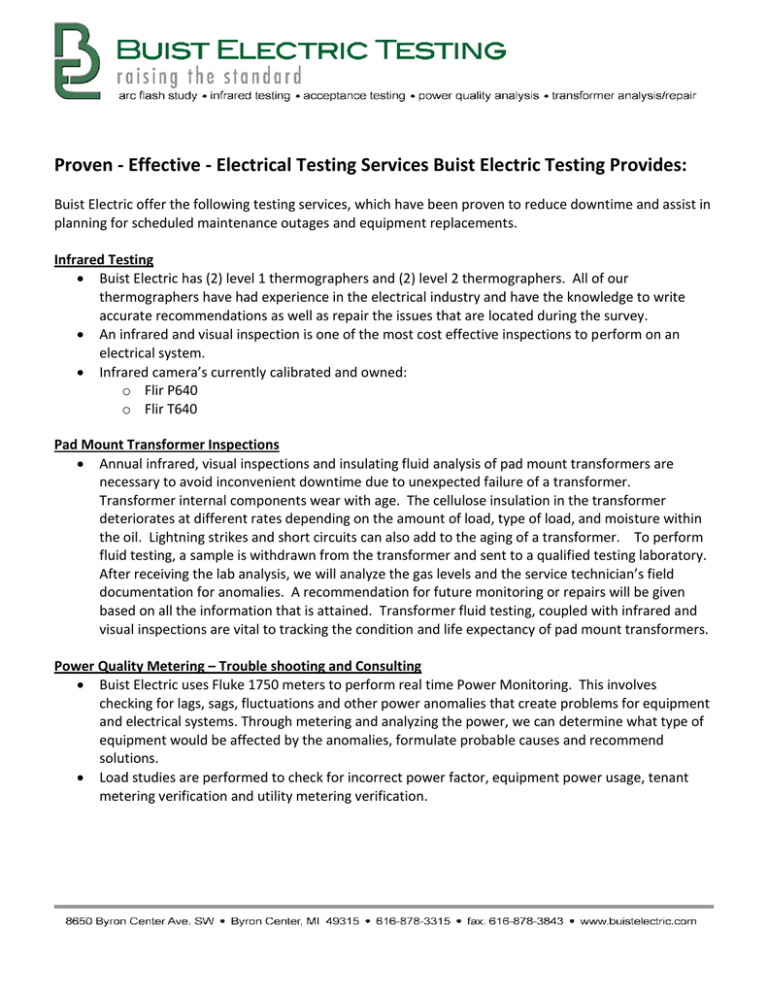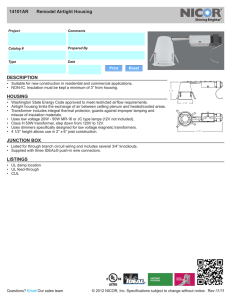Proven - Effective - Electrical Testing Services
advertisement

Proven - Effective - Electrical Testing Services Buist Electric Testing Provides: Buist Electric offer the following testing services, which have been proven to reduce downtime and assist in planning for scheduled maintenance outages and equipment replacements. Infrared Testing Buist Electric has (2) level 1 thermographers and (2) level 2 thermographers. All of our thermographers have had experience in the electrical industry and have the knowledge to write accurate recommendations as well as repair the issues that are located during the survey. An infrared and visual inspection is one of the most cost effective inspections to perform on an electrical system. Infrared camera’s currently calibrated and owned: o Flir P640 o Flir T640 Pad Mount Transformer Inspections Annual infrared, visual inspections and insulating fluid analysis of pad mount transformers are necessary to avoid inconvenient downtime due to unexpected failure of a transformer. Transformer internal components wear with age. The cellulose insulation in the transformer deteriorates at different rates depending on the amount of load, type of load, and moisture within the oil. Lightning strikes and short circuits can also add to the aging of a transformer. To perform fluid testing, a sample is withdrawn from the transformer and sent to a qualified testing laboratory. After receiving the lab analysis, we will analyze the gas levels and the service technician’s field documentation for anomalies. A recommendation for future monitoring or repairs will be given based on all the information that is attained. Transformer fluid testing, coupled with infrared and visual inspections are vital to tracking the condition and life expectancy of pad mount transformers. Power Quality Metering – Trouble shooting and Consulting Buist Electric uses Fluke 1750 meters to perform real time Power Monitoring. This involves checking for lags, sags, fluctuations and other power anomalies that create problems for equipment and electrical systems. Through metering and analyzing the power, we can determine what type of equipment would be affected by the anomalies, formulate probable causes and recommend solutions. Load studies are performed to check for incorrect power factor, equipment power usage, tenant metering verification and utility metering verification. Ground Resistance Testing Fall of potential testing is utilized to verify adequate grounding at electrical services and equipment installations. Proper grounding should be verified for equipment and personnel protection. A good grounding system will improve the reliability of equipment and can reduce damage due to surges on the system. Insulation Resistance Testing Insulation tests are used to determine the quality or condition of the insulation systems of electrical equipment. When performed properly, the testing will indicate a failing insulation system, before a fault occurs. Hipotential Testing In a typical hipot test, high voltage is applied between a product's current-carrying conductors and its metallic shielding. The resulting current that flows through the insulation, known as leakage current, is monitored by the hipot tester. This is typically a pass or fail test and is not encouraged on existing medium voltage cable. Transformer Turns Ratio Testing The proper voltage of a transformer relies almost entirely on the electrical properties of its windings. With this test, transformers are tested to verify that their electrical properties have not changed from design specifications. The TTR test applies voltage to the high voltage winding of a transformer and accurately measures the resulting voltage from the low voltage winding. In addition to turns ratio, the unit measures excitation current, phase angle deviation between the high and low voltage windings and percent ratio error Primary Injection Breaker Testing High current with low voltage is applied via a breaker test set to the breaker and multiple tests are then performed to ensure the breaker and trip units are operating as designed Measure insulation resistance for one minute on each pole, phase to phase and phase to ground with breaker closed and across each open pole Measure contact pole resistance on each respective phase Ensure readings fall within manufactures recommended tolerances Protective Relay Testing Mechanical or electronic Typically found in substations and larger plants Time Overcurrent Reverse Power Over under voltage Over under frequency Ground directional Sync check Distance relays Inspections and Frequency of Testing: Infrared and Visual Inspections: Annually or more frequently based on criticality of equipment or harsh environments. Power Quality Metering: Use as needed as power issues arise Insulation Resistance Testing: Every three years Transformer Turns Ratio Testing: Dry Type (small): Every three years Dry Type (large): Every two years Liquid Filled: Every two years Dissolved Gas in Oil Analysis: Annually Primary Injection Breaker Testing: Every three years Breaker Exercising: Annually Ground Fault Testing: Manufactures recommended interval (Annually or after event occurs) Protective Relay Testing: Annually or as specified Power Factor Testing: Use as necessary to determine insulation quality Cleaning: Based on the environment and type of facility equipment is installed or located The above noted testing is based on NETA Maintenance Testing Specifications and NFPA 70B for Electrical Power Distribution Equipment and Systems. Buist Electric Testing is a NETA Alliance partner and utilizes ANSI/NETA ATS and MTS-2013 for testing specifications and procedures.
